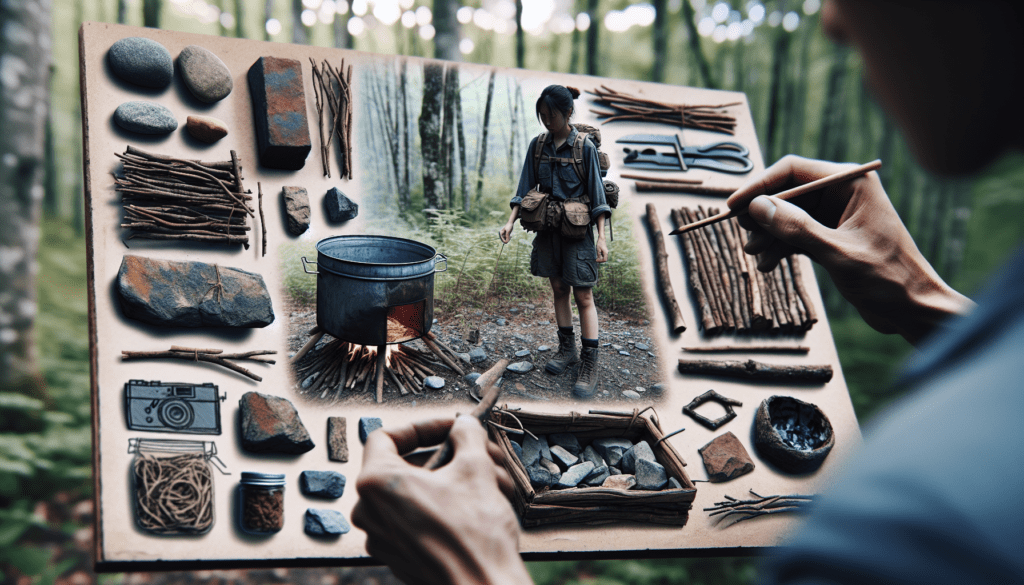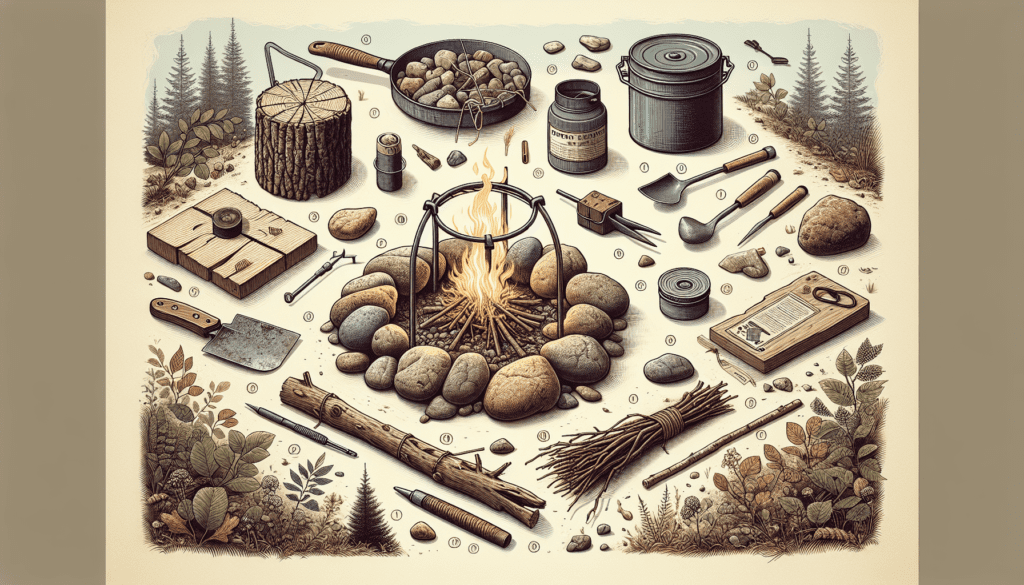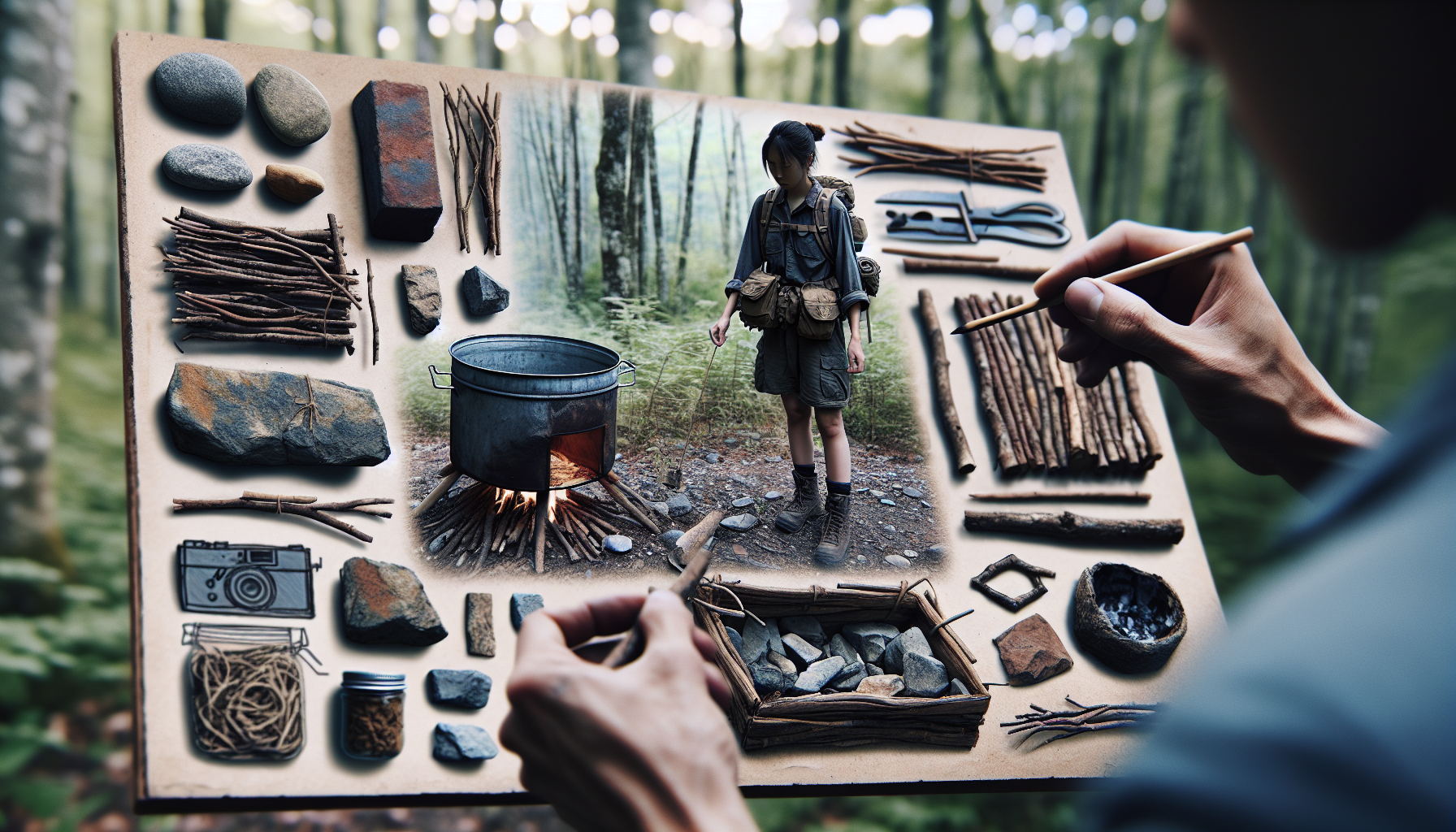Imagine yourself deep in the heart of the untamed wilderness, surrounded by nature’s majestic beauty. The crackling sound of a fire lingers in the air as the warm glow illuminates your surroundings. In this article, you will learn the art of building a simple stove in the wild, allowing you to cook food and keep warm even in the most remote locations. With just a few basic materials and some handy tips, you will master the skill of creating a functional stove that will enhance your outdoor adventures and make you feel at home in nature’s embrace. So let’s get started and unlock the secrets of a simple yet efficient stove construction.
Materials Needed
To build a simple stove in the wild, you will need a few basic materials. Gather the following items before you begin:
Tin cans
Start by collecting two tin cans of different sizes. These cans will be the main components of your stove.
Knife or scissors
You will need a knife or scissors to cut and shape the tin cans. Make sure you use a tool that is sharp and easy to handle.
Small rocks or pebbles
Collect small rocks or pebbles that you can use to fill the space between the cans. These rocks will help distribute the heat evenly.
Dry leaves or twigs
Dry leaves or twigs will serve as fuel for your stove. Look for them around the area where you plan to build the stove.
Matches or a lighter
To start a fire, you will need matches or a lighter. Make sure you have a reliable ignition source like matches or a lighter.
Water
Water is essential for safety purposes. Keep a small amount of water nearby to create a fireproof barrier and extinguish the stove when you’re done cooking.
Choosing the Right Location
Before you start building your stove, it’s crucial to find the right location. Consider the following factors when choosing where to build your stove:
Look for a clear and open area
Find a spacious area that is free from any obstacles or obstructions. Having a clear and open space will ensure safety and allow proper airflow.
Ensure there are no flammable materials nearby
Make sure there are no flammable materials, such as dry grass or loose debris, in close proximity to your chosen location. This will prevent accidental fires.
Check for wind direction and strength
Pay attention to the wind direction and strength in the area. Avoid building the stove in a spot where the wind could potentially blow the flames towards flammable objects or structures.
Avoid building the stove on damp or wet ground
Select a dry area to build your stove. Building on damp or wet ground may affect the stove’s stability and ignite the surrounding materials.

Preparing the Stove Base
Once you have found the perfect location for your stove, it’s time to prepare the stove base. Follow these steps:
Find a flat and stable surface
Look for a flat and stable surface where you can set up your stove. This will ensure that the stove remains balanced and secure while in use.
Remove any bushes, grass, or debris
Clear the area of any bushes, grass, or debris. Removing unwanted vegetation and debris will provide a clean and safe environment for your stove.
Clear a circular space approximately 1-2 feet in diameter
Using your feet or any available tool, clear a circular space on the ground with a diameter of around 1 to 2 feet. This is where you will build your stove.
Creating the Stove Body
Now it’s time to assemble the stove body using the tin cans you gathered earlier. Follow these steps:
Find two tin cans of different sizes
Locate two tin cans, one larger and one smaller. The larger can will serve as the outer shell, while the smaller can will act as the inner chamber for the fire.
Remove the tops and bottoms of both cans
Using your knife or scissors, carefully remove the tops and bottoms of both tin cans. This will create open ends for the cans.
Cut slits along the sides of the larger can
On the larger can, cut evenly spaced slits along the sides. These slits will improve airflow and allow the fire to burn more efficiently.
Cut out a small opening near the top of the larger can
Near the top of the larger can, cut out a small opening. This will act as an air vent, allowing oxygen to fuel the fire.
Place the smaller can inside the larger can
Insert the smaller can into the larger can, making sure it fits snugly. The smaller can will serve as the fuel chamber for the stove.

Building the Fuel Chamber
The fuel chamber is where you will place the rocks or pebbles, as well as the dry leaves or twigs. Here’s how to build it:
Fill the space between the cans with small rocks or pebbles
Start by filling the space between the larger and smaller cans with small rocks or pebbles. This will help distribute the heat evenly throughout the stove.
Ensure the rocks are tightly packed and reach the top of the smaller can
Make sure the rocks are tightly packed and reach the top of the smaller can. This will provide stability and prevent the fire from spreading unevenly.
Leave a small gap near the top for airflow
Near the top of the smaller can, leave a small gap between the rocks to allow airflow. This will help the fire burn properly and maintain a steady flame.
Add a layer of dry leaves or twigs on top of the rocks
Place a layer of dry leaves or twigs on top of the rocks. These fuel sources will catch fire easily and provide the initial flames for your stove.
Lighting the Stove
Now that your stove is complete, it’s time to light the fire. Follow these steps to safely ignite your stove:
Pour a small amount of water around the stove to create a fireproof barrier
Before lighting the stove, pour a small amount of water around the stove’s base. This will create a fireproof barrier and prevent any accidental spreading of the flames.
Light the dry leaves or twigs with matches or a lighter
Using matches or a lighter, carefully light the dry leaves or twigs that are on top of the rocks. Make sure you have a good flame source to ignite the fuel.
Blow gently into the opening near the top of the larger can to increase airflow
To increase airflow and help the fire grow, blow gently into the opening near the top of the larger can. This will provide oxygen to fuel the flames.
Adjust the size of the opening to control the flame intensity
To control the intensity of the flame, adjust the size of the opening near the top of the larger can. A larger opening will result in a more intense flame, while a smaller opening will create a milder heat.
Cooking on the Stove
Once your stove is lit and the flames have settled, it’s time to start cooking. Follow these steps for a successful cooking experience:
Wait for the flames to die down and turn into embers
Allow the flames to die down and turn into embers before placing any cookware on the stove. This will ensure a more controlled and even heat distribution.
Place a cooking pot or pan on top of the smaller can
Carefully place a cooking pot or pan on top of the smaller can. Make sure the cookware is stable and sits securely on the stove.
Add your food or ingredients to the pot
Add your desired food or ingredients to the pot. Ensure proper seasoning and flavorings to create a delicious meal while enjoying the great outdoors.
Monitor the heat and adjust the flame if necessary
Keep a close eye on the heat and flame intensity. If the flame is too high, reduce the airflow or adjust the size of the opening. If the flame is too low, gently blow into the opening to increase the airflow.
Use a stick or tongs to remove the pot from the stove
After cooking, use a stick or tongs to carefully remove the pot or pan from the stove. The cookware will be hot, so make sure to use proper handling techniques to avoid burns.
Extinguishing the Stove
Safety is essential when using a stove in the wild. Follow these steps to safely extinguish your stove:
Allow the fire to burn out naturally
Once you are done cooking, allow the fire to burn out naturally. Do not attempt to speed up the process by pouring water directly on the flames.
Pour water over the stove and surrounding area to ensure it is completely extinguished
After the fire has burned out, pour water over the stove and the surrounding area to ensure it is completely extinguished. This will prevent any remaining embers from reigniting.
Wait until the stove and rocks cool down before touching or moving them
Before handling or moving the stove and rocks, make sure they have cooled down completely. Touching hot metal or rocks can cause severe burns, so exercise caution.
Safety Precautions
To ensure your safety, keep the following precautions in mind when using a stove in the wild:
Avoid building the stove in a confined or enclosed space
Never build the stove in a confined or enclosed space. Doing so can lead to a buildup of carbon monoxide, which is highly dangerous.
Keep a safe distance from the stove while it is lit
Maintain a safe distance from the stove while it is lit to avoid accidental burns or injuries. Use caution when approaching the stove and make sure to stay focused on your surroundings.
Never leave the stove unattended
Never leave the stove unattended while it is lit. Always ensure that someone is supervising the stove and keeping a close eye on the flames.
Avoid touching the metal cans or rocks while the stove is hot
Avoid touching the metal cans or rocks while the stove is hot. They can retain heat for a significant amount of time and can cause severe burns.
Cleaning Up
After you have finished using the stove, it’s important to clean up the area and leave it undisturbed. Follow these steps to properly clean up:
Remove the smaller can from the larger can
Carefully remove the smaller can from the larger can. Set them aside for disposal or future use.
Properly dispose of any ashes or burning materials
Dispose of any ashes or burning materials in a safe and responsible manner. Ensure that you do not leave any fire hazards behind.
Pack all your belongings and leave the area clean and undisturbed
Before leaving the area, pack all your belongings and ensure that you have left the space clean and undisturbed. Leave no trace of your stove-building activity.
Building a simple stove in the wild can be a rewarding experience. By following these steps and taking necessary safety precautions, you can enjoy a hot meal while enjoying the beauty of nature. Remember to always respect the environment and leave no trace behind. Happy cooking!

